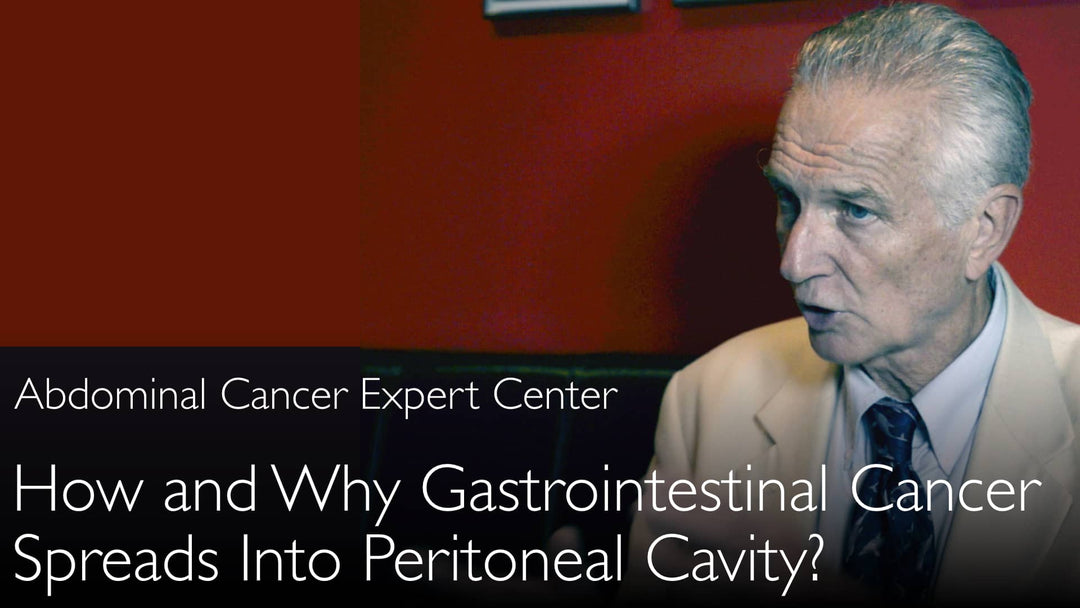Leading expert in peritoneal metastatic cancer treatment, Dr. Paul Sugarbaker, MD, explains how gastrointestinal and ovarian cancers spread within the abdomen. He details the pathways of peritoneal dissemination, including full-thickness bowel wall invasion. Dr. Sugarbaker describes the development of cytoreductive surgery and HIPEC, a heated chemotherapy bath. This combined procedure offers a curative strategy for select stage 4 cancers confined to the peritoneal cavity. Best results are often seen with appendiceal cancer, which rarely spreads to distant organs like the liver.
Understanding Peritoneal Metastases: Pathways, Diagnosis, and Advanced HIPEC Treatment
Jump To Section
- Pathways of Peritoneal Cancer Spread
- Gastrointestinal Cancer Dissemination
- Ovarian Cancer Peritoneal Metastases
- Appendiceal Cancer Treatment Success
- Cytoreductive Surgery and HIPEC
- The Role of a Medical Second Opinion
- Full Transcript
Pathways of Peritoneal Cancer Spread
Dr. Paul Sugarbaker, MD, a renowned gastrointestinal cancer surgeon, outlines the primary ways cancer disseminates within the abdomen. Malignancies can spread to regional lymph nodes, which a surgeon can often remove if they are involved. Cancer can also travel through the bloodstream to form distant metastases in organs like the liver. The third critical pathway is direct dissemination into the peritoneal cavity itself. This peritoneal spread is a hallmark of advanced gastrointestinal and gynecological cancers.
Gastrointestinal Cancer Dissemination
Dr. Paul Sugarbaker, MD, explains how cancers like colon, rectal, and gastric cancer gain entry to the peritoneal space. This occurs through full-thickness invasion of the bowel wall by the tumor. Once the cancer penetrates the entire wall, individual cancer cells or small clusters are shed. These cancerous seedlings then spread in a random manner throughout the peritoneal cavity. This process creates numerous small metastatic deposits on the surfaces of abdominal organs.
Ovarian Cancer Peritoneal Metastases
The mechanism of spread for ovarian cancer differs from gastrointestinal malignancies. Dr. Paul Sugarbaker, MD, notes that the ovary has a very thin capsule, or the cancer may originate in the fallopian tubes. Dissemination into the peritoneal space happens very early in the natural history of ovarian cancer. The cancer cells move in a retrograde manner out into the peritoneal cavity. This early and widespread peritoneal seeding is why ovarian cancer is often diagnosed at an advanced stage.
Appendiceal Cancer Treatment Success
Dr. Paul Sugarbaker, MD, highlights appendiceal cancer as a malignancy where treatment is particularly effective. Appendix cancer very rarely metastasizes to the liver or lymph nodes. Instead, it often causes the appendix to rupture early in its development. This rupture releases mucinous cancer cells throughout the peritoneal cavity. Because the disease is typically confined to the abdomen, a comprehensive surgical and chemotherapeutic strategy can be highly successful. Dr. Paul Sugarbaker, MD, states that the best results for cytoreductive surgery and HIPEC began with appendiceal cancer.
Cytoreductive Surgery and HIPEC
Dr. Paul Sugarbaker, MD, and his colleagues developed a combined treatment strategy for peritoneal metastases. The first step is cytoreductive surgery, which aims to remove all visible tumor deposits from the abdomen. This is followed immediately by Hyperthermic Intraperitoneal Chemotherapy (HIPEC). HIPEC is a heated chemotherapy solution that is circulated throughout the peritoneal cavity. The heat enhances the penetration and effectiveness of the chemotherapy against any remaining microscopic cancer cells. This regional treatment is maximally effective when peritoneal dissemination is the only site of metastatic disease.
The Role of a Medical Second Opinion
Seeking a medical second opinion is crucial for patients diagnosed with advanced abdominal cancers. As Dr. Paul Sugarbaker, MD, discusses with Dr. Anton Titov, MD, a second opinion can clarify a complex diagnosis of colon or ovarian cancer with peritoneal spread. It confirms whether a curative approach, like cytoreductive surgery and HIPEC, is a viable option. This process helps patients and families select the most precise and advanced treatment plan for stage 4 disease. A second opinion ensures access to the best peritoneal metastatic cancer treatment available.
Full Transcript
Dr. Anton Titov, MD: Let's start with a general question of how gastrointestinal cancer spreads alongside the peritoneum. Maybe you could give an example of gastrointestinal cancers that can spread into the peritoneal cavity. How do the cancer cells get entry to the peritoneal cavity? Where do cancer cells go in the peritoneal space? What is the peritoneal cancer treatment strategy when that happens?
Dr. Paul Sugarbaker, MD: Maybe we could even be a little bit more general. We can ask the question: how does a malignancy within the abdominal cavity disseminate? Cancer can go to the lymph nodes. The surgeon can remove these lymph nodes if they are involved with cancer.
Gastrointestinal cancer or ovarian cancer can go through the bloodstream to the liver and give rise to liver metastases. An alternative pathway for cancer dissemination is through the bowel wall. This is bowel cancer, rectal cancer, gastric cancer.
Cancer spreads through the wall of the colon or through the wall of the stomach. Then those cancer seedlings just spread in a random manner in and around the peritoneal space. It is usually full-thickness invasion of the bowel wall by gastrointestinal cancer.
There are gynecologic malignancies such as ovarian cancer. In ovarian cancer, the dissemination into the peritoneal space happens very early in the natural history of ovarian cancer. The ovary has a very thin capsule, or the ovarian cancer comes from the fallopian tubes. Ovarian cancer goes in a retrograde manner out into the peritoneal space.
It is generally a gastrointestinal or ovarian cancer somewhere else that then finds access to the peritoneal cavity.
Dr. Anton Titov, MD: Therefore, cancers can gain entry to the peritoneum and spread in the peritoneal cavity. It is colorectal cancer, colon cancer and rectal cancer, and more rare malignancy, such as peritoneal mesothelioma or appendix cancer.
Dr. Paul Sugarbaker, MD: Correct. What we would like for our cancer treatments to be maximally effective is we treat the peritoneal dissemination, peritoneal metastases. We ensure it is the only site for metastatic disease.
Sometimes you have lymph node metastases and liver metastases and peritoneal metastases. Then the likelihood that some surgical strategy will be helpful in cancer treatment is very small.
For example, appendiceal cancer (appendix cancer) almost never metastasizes to the liver. Only a few percent of appendix cancer metastasizes to the liver. Appendix cancer very rarely metastasizes to the lymph nodes. But early in the natural history of appendix cancer, the appendix bursts. These mucinous cancer cells go all over the place. Our best results, and where this all started, was with appendiceal cancer malignancy.







